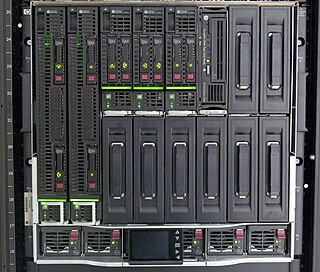
InfiniBand (IB) is a computer networking communications standard used in high-performance computing that features very high throughput and very low latency. It is used for data interconnect both among and within computers. InfiniBand is also used as either a direct or switched interconnect between servers and storage systems, as well as an interconnect between storage systems. It is designed to be scalable and uses a switched fabric network topology. Between 2014 and June 2016, it was the most commonly used interconnect in the TOP500 list of supercomputers.

PCI Express, officially abbreviated as PCIe or PCI-e, is a high-speed serial computer expansion bus standard, meant to replace the older PCI, PCI-X and AGP bus standards. It is the common motherboard interface for personal computers' graphics cards, capture cards, sound cards, hard disk drive host adapters, SSDs, Wi-Fi, and Ethernet hardware connections. PCIe has numerous improvements over the older standards, including higher maximum system bus throughput, lower I/O pin count and smaller physical footprint, better performance scaling for bus devices, a more detailed error detection and reporting mechanism, and native hot-swap functionality. More recent revisions of the PCIe standard provide hardware support for I/O virtualization.

HIPPI, short for High Performance Parallel Interface, is a computer bus for the attachment of high speed storage devices to supercomputers, in a point-to-point link. It was popular in the late 1980s and into the mid-to-late 1990s, but has since been replaced by ever-faster standard interfaces like Fibre Channel and 10 Gigabit Ethernet.

High-Definition Multimedia Interface (HDMI) is a proprietary audio/video interface for transmitting uncompressed video data and compressed or uncompressed digital audio data from an HDMI-compliant source device, such as a display controller, to a compatible computer monitor, video projector, digital television, or digital audio device. HDMI is a digital replacement for analog video standards.

Small Form-factor Pluggable (SFP) is a compact, hot-pluggable network interface module format used for both telecommunication and data communications applications. An SFP interface on networking hardware is a modular slot for a media-specific transceiver, such as for a fiber-optic cable or a copper cable. The advantage of using SFPs compared to fixed interfaces is that individual ports can be equipped with different types of transceivers as required, with the majority including optical line terminals, network cards, switches and routers.
In computing, remote direct memory access (RDMA) is a direct memory access from the memory of one computer into that of another without involving either one's operating system. This permits high-throughput, low-latency networking, which is especially useful in massively parallel computer clusters.

DisplayPort (DP) is a proprietary digital display interface developed by a consortium of PC and chip manufacturers and standardized by the Video Electronics Standards Association (VESA). It is primarily used to connect a video source to a display device such as a computer monitor. It can also carry audio, USB, and other forms of data.

The IBM BladeCenter was IBM's blade server architecture, until it was replaced by Flex System in 2012. The x86 division was later sold to Lenovo in 2014.
The "22 nm" node is the process step following 32 nm in CMOS MOSFET semiconductor device fabrication. The typical half-pitch for a memory cell using the process is around 22 nm. It was first demonstrated by semiconductor companies for use in RAM memory in 2008. In 2010, Toshiba began shipping 24 nm flash memory chips, and Samsung Electronics began mass-producing 20 nm flash memory chips. The first consumer-level CPU deliveries using a 22 nm process started in April 2012 with the Intel Ivy Bridge processors.
40 Gigabit Ethernet (40GbE) and 100 Gigabit Ethernet (100GbE) are groups of computer networking technologies for transmitting Ethernet frames at rates of 40 and 100 gigabits per second (Gbit/s), respectively. These technologies offer significantly higher speeds than 10 Gigabit Ethernet. The technology was first defined by the IEEE 802.3ba-2010 standard and later by the 802.3bg-2011, 802.3bj-2014, 802.3bm-2015, and 802.3cd-2018 standards. The first succeeding Terabit Ethernet specifications were approved in 2017.
Mobile High-Definition Link (MHL) is an industry standard for a mobile audio/video interface that allows the connection of smartphones, tablets, and other portable consumer electronics devices to high-definition televisions (HDTVs), audio receivers, and projectors. The standard was designed to share existing mobile device connectors, such as Micro-USB, and avoid the need to add video connectors on devices with limited space for them.

Mac Mini is a small form factor desktop computer developed and marketed by Apple Inc. As of 2022, it is positioned between the consumer all-in-one iMac and the professional Mac Studio and Mac Pro as one of four current Mac desktop computers. Since launch, it has shipped without a display, keyboard, and mouse. The machine was initially branded as "BYODKM" as a strategic pitch to encourage users to switch from Windows and Linux computers.

BladeSystem is a line of blade server machines from Hewlett Packard Enterprise that was introduced in June 2006.

Active cables are copper cables used for data transmission that use an electronic circuit to boost their performance. Without an electronic circuit, a cable is considered passive. Unlike passive cables, which can suffer from data degradation due to issues such as attenuation, crosstalk, and group velocity distortion, active cables contain one or more integrated circuits to address these problems. This active boosting allows cables to be more compact, thinner, and longer, and to transmit data faster than passive cables.
Thunderbolt is the brand name of a hardware interface for the connection of external peripherals to a computer. It was developed by Intel in collaboration with Apple. It was initially marketed under the name Light Peak, and first sold as part of an end-user product on 24 February 2011.
Silicon Photonics Link is a silicon-based optical data connection developed by Intel Corporation which uses silicon photonics and hybrid silicon laser, it provides 50 Gbit/s bandwidth. Intel expected the technology to be in products by 2015.
Hella Zippy is Intel's code-name for a high-speed integrated, end-to-end, silicon-based optical system. The prototype of this technology is essentially a two-chip system that can optically transmit and receive data at 50 Gbit/s or higher. A transmitter chip uses four hybrid silicon lasers running at 12.5 Gbit/s each and operating at different wavelengths. The lasers are essentially part of the silicon wafer, eliminating the need for a separate optical module, as in Light-Peak. The reason for this design is due to the increased need for transferring data at very high speeds and the only way to achieve this is to introduce Optical Technology. Copper becomes a bottleneck at 10 Gbit/s. Silicon-based optical interconnects are also highly immune to errors. Hella Zippy is predicted to supersede Intel's own Light Peak in the coming years.

The Linux-IOTarget (LIO) is an open-source Small Computer System Interface (SCSI) target implementation included with the Linux kernel.

Mellanox Technologies Ltd. was an Israeli-American multinational supplier of computer networking products based on InfiniBand and Ethernet technology. Mellanox offered adapters, switches, software, cables and silicon for markets including high-performance computing, data centers, cloud computing, computer data storage and financial services.

HiSilicon is a Chinese fabless semiconductor company based in Shenzhen, Guangdong province and wholly owned by Huawei. HiSilicon purchases licenses for CPU designs from ARM Holdings, including the ARM Cortex-A9 MPCore, ARM Cortex-M3, ARM Cortex-A7 MPCore, ARM Cortex-A15 MPCore, ARM Cortex-A53, ARM Cortex-A57 and also for their Mali graphics cores. HiSilicon has also purchased licenses from Vivante Corporation for their GC4000 graphics core.













